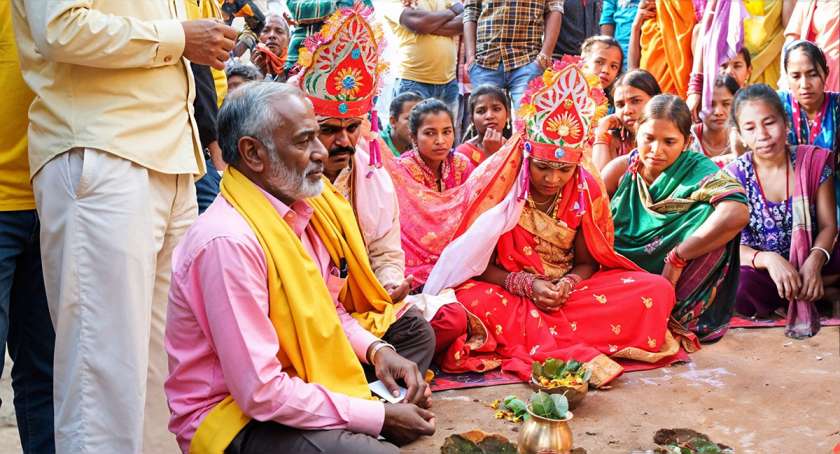The Unique Marriage Traditions of Odisha’s Indigenous Communities
Odisha, a land of rich historical records and diverse traditions, is home to over 60 indigenous tribes. These communities have preserved their customs, rituals, and traditions for centuries. Their marriage practices stand out as unique reflections of their cultural identity. Unlike conventional urban weddings, tribal marriages in Odisha are deeply rooted in nature, symbolism, and age-old traditions passed down through generations.
The Significance of Marriage Traditions in Tribal Culture
For the indigenous tribes of Odisha, marriage is more than just a social contract—it is a sacred union that binds two individuals and their families and communities. Marriage ceremonies among these tribes are often simple, yet they carry profound cultural and spiritual significance. Unlike mainstream weddings that involve grand ceremonies and expensive rituals, tribal marriages emphasize harmony with nature, community participation, and egalitarian values.
Pre-Marriage Rituals and Courtship Traditions
- The Role of Community in Matchmaking: Elders and other community members are crucial in the traditional matchmaking process practiced by several tribal communities in Odisha. Unlike arranged weddings in mainstream society, these matchmakings are frequently voluntary and involve both the bride and groom.
- The Dhumkuria Tradition (Youth Dormitory System): Among tribes such as the Juang and Santhal, the Dhumkuria (youth dormitory) system plays a significant role in selecting life partners. Young children live in separate dormitories where they learn social values, cultural practices, and the skills needed to choose a suitable partner. This unique tradition allows them to develop relationships organically, leading to marriage based on mutual affection.
- Marriage by Capture and Elopement: Certain tribes, such as the Saura and Bonda, practice symbolic marriage capture. Here, a groom “kidnaps” the bride, which is often pre-planned and accepted by both families. Similarly, elopement marriages are common among tribes like the Kharia and Munda, where couples escape together to avoid family objections and later return to seek approval.
Wedding Ceremonies and Rituals
- Simplicity and Nature-Centric Celebrations: Unlike mainstream Hindu weddings, tribal weddings in Odisha are simple yet meaningful. Many ceremonies occur in open fields, sacred groves, or village courtyards. Village elders rather than religious priests often conduct the wedding rituals.
- Exchange of Mahua Liquor: Mahua, a traditional alcoholic drink made from the Mahua flower, plays a significant role in tribal weddings. The groom’s family offers Mahua liquor to the bride’s family as a token of acceptance. This exchange symbolizes unity, joy, and social bonding.
- Wedding Attire and Ornaments: Tribal brides and grooms wear traditional handwoven clothes made from natural fabrics. Women often adorn themselves with elaborate silver jewelry, beads, and shell ornaments, while men wear simple yet elegant dhotis with traditional turbans. Natural dyes and handcrafted fabrics add an artistic touch to their wedding attire.
- Ritual of Walking Around the Fire or a Sacred Tree: Instead of the conventional Hindu practice of taking seven pheras (circumambulations) around the sacred fire, many tribal couples walk around a tree, such as a Sal or Banyan tree. This practice symbolizes their eternal bond with nature and commitment to each other.
- Community Feasting and Dance Celebrations: Tribal weddings are joyous occasions marked by elaborate feasts, traditional music, and group dances. Community members prepare a grand meal featuring locally sourced ingredients, including millet-based dishes, smoked meats, and fresh forest produce. Folk dances, like the Dhemsa dance of the Gadaba community and the Karma dance of the Ho group, add vibrancy to the celebrations.
Post-Wedding Traditions
- Bride’s Stay at Her Parental Home: In many communities, such as the Kondh and Paroja, the bride does not immediately move to her husband’s house. Instead, she stays with her parents for months or even years after marriage. This period allows the couple to strengthen their bond while the bride remains part of her natal family.
- The Ghar Jamai System: Certain communities, such as the Santhal and Munda, follow the tradition of *Ghar Jamai*, where the groom lives with the bride’s family and works for them. This practice is widespread in cases where the bride has no brothers to inherit property.
- Polygamy and Divorce Practices: Unlike mainstream society, where divorce is often stigmatized, many tribal communities in Odisha have a more liberal approach. If a marriage does not work out, couples can separate amicably. In some communities, such as the Juang and Saura groups, people practice polygamy for economic and social reasons rather than out of patriarchal dominance.
Changing Trends and Modern Influences
While tribal societies have preserved these unique marriage customs for centuries, modern influences gradually shape their traditions. Increased exposure to urban lifestyles, education, and legal reforms are leading to changes in traditional practices. Love marriages, inter-caste unions, and government-registered weddings are becoming more common among younger generations. However, cultural preservationists and tribal leaders try to keep their traditions alive while adapting to modern realities.
Conclusion
The indigenous communities of Odisha offer a fascinating look into the diversity and richness of India’s cultural fabric. Their marriage traditions, deeply intertwined with nature and community values, highlight the importance of love, consent, and simplicity in relationships. As modernization continues to shape tribal societies, preserving these unique traditions will be crucial in maintaining the cultural identity of Odisha’s indigenous people. These customs serve as a reminder that marriage is not just about opulence but also about mutual respect, unity, and harmony with nature.


